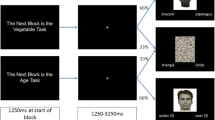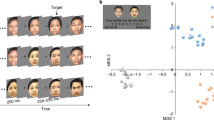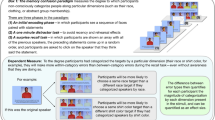Abstract
We investigated whether individual differences in racial bias among white participants predict the recruitment, and potential depletion, of executive attentional resources during contact with black individuals. White individuals completed an unobtrusive measure of racial bias, then interacted with a black individual, and finally completed an ostensibly unrelated Stroop color-naming test. In a separate functional magnetic resonance imaging (fMRI) session, subjects were presented with unfamiliar black male faces, and the activity of brain regions thought to be critical to executive control was assessed. We found that racial bias predicted activity in right dorsolateral prefrontal cortex (DLPFC) in response to black faces. Furthermore, activity in this region predicted Stroop interference after an actual interracial interaction, and it statistically mediated the relation between racial bias and Stroop interference. These results are consistent with a resource depletion account of the temporary executive dysfunction seen in racially biased individuals after interracial contact.
This is a preview of subscription content, access via your institution
Access options
Subscribe to this journal
Receive 12 print issues and online access
$209.00 per year
only $17.42 per issue
Buy this article
- Purchase on Springer Link
- Instant access to full article PDF
Prices may be subject to local taxes which are calculated during checkout



Similar content being viewed by others
References
Blascovich, J., Mendes, W.B., Hunter, S.B., Lickel, B. & Kowai-Bell, N. Perceiver threat in social interactions with stigmatized others. J. Pers. Soc. Psychol. 80, 253–267 (2001).
Devine, P.G. & Vasquez, K.A. The rocky road to positive intergroup relations. in Confronting Racism. The Problem and the Response (eds. Eberhardt, J.L. & Fiske, S.T.) 234–262 (Sage, California, 1998).
Richeson, J.A. & Shelton, J.N. When prejudice does not pay. Effects of interracial contact on executive function. Psychol. Sci. 14, 287–290 (2003).
Baumeister, R.F., Muraven, M. & Tice, D.M. Ego depletion: a resource model of volition, self-regulation, and controlled processing. Soc. Cogn. 8, 130–150 (2000).
Engle, R.W., Conway, A.R.A., Tuholski, S.W. & Shisler, R.J. A resource account of inhibition. Psychol. Sci. 6, 122–125 (1995).
Vohs, K.D. & Heatherton, T.F. Self-regulatory failure: a resource-depletion approach. Psychol. Sci. 11, 249–254 (2000).
Devine, P.G. Stereotypes and prejudice: their automatic and controlled components. J. Pers. Soc. Psychol. 56, 5–18 (1989).
Shelton, J.N. Interpersonal concerns in social encounters between majority and minority group members. Group. Process. Intergroup Relat. 6, 171–186 (2003).
von Hippel, W., Silver, L.A. & Lynch, M.E. Stereotyping against your will: the role of inhibitory ability in stereotyping and prejudice among the elderly. Pers. Soc. Psychol. Bull. 26, 523–532 (2000).
Lepore, L. & Brown, R. Category and stereotype activation: Is prejudice inevitable? J. Pers. Soc. Psychol 72, 275–287 (1997).
Shallice, T. & Burgess, P. Supervisory control of action and thought selection. in Attention: Selection, Awareness and Control (eds. Baddeley, A. & Weiskrantz, L.) 171–187 (Clarendon, Oxford, 1993).
Carter C.S. et al. Anterior cingulate cortex error detection and the online monitoring of performance. Science 280, 747–749 (1998).
Cohen, J.D., Botvinick, M. & Carter, C.S. Anterior cingulate and prefrontal cortex: who's in control? Nat. Neurosci. 3, 421–423 (2000).
Dehaene, S., Posner, M.I. & Tucker, D.M. Localization of a neural system for error detection and compensation. Psychol. Sci. 5, 303–305 (1994).
Miller, E.K. & Cohen, J.D. An integrative theory of prefrontal cortex function. Annu. Rev. Neurosci. 24, 167–202 (2001).
MacDonald, A.W., Cohen, J.D., Stenger, V.A. & Carter, C.S. Dissociating the role of the dorsolateral prefrontal and anterior cingulate cortex in cognitive control. Science 288, 1835–1838 (2000).
Kane, M.J. & Engle, R.W. The role of prefrontal cortex in working memory capacity, executive attention, and general fluid intelligence: an individual-differences perspective. Psychonom. Bull. Rev. 9, 637–671 (2002).
Smith, E.E. & Jonides, J. Storage and executive processes in the frontal lobes. Science 283, 1657–1661 (1999).
Milham, M.P., Banich, M.T., Claus, E.D. & Cohen, N.J. Practice-related effects demonstrate complementary roles of anterior cingulate and prefrontal cortices in attentional control. Neuroimage 18, 483–493 (2003).
Banich, M.T. et al. Prefrontal regions play a predominant role in imposing an attentional “set:” evidence from fMRI. Cogn. Brain Res. 10, 1–9 (2000).
Kimberg, D.Y. & Farah, M.J. A unified account of cognitive impairments following frontal lobe damage: the role of working memory in complex organized behavior. J. Exp. Psychol. Gen. 122, 411–482 (1993).
Fuster, J.M. Proceedings of the human cerebral cortex: from gene to structure and function. Brain Res. Bull. 52, 331–336 (2000).
Gehring, W.J. & Knight, R.T. Prefrontal-cingulate interactions in action monitoring. Nat. Neurosci. 3, 516–520 (2000).
Chee, M.W.L., Sriram, N., Soon, C.S. & Lee, K.M. Dorsolateral prefrontal cortex and the implicit association of concepts and attributes. Neuroreport 11, 135–140 (1999).
Leung, H.C., Skudlarski, P., Gatenby, J.C., Peterson, B.S. & Gore, J.C. An event-related functional MRI study of the Stroop color word interference task. Cereb. Cortex 10, 552–560 (2000).
Garavan, H., Ross, T.J. & Stein, E.A. Right hemispheric dominance of inhibitory control. Proc. Natl. Acad. Sci. USA 96, 8301–8306 (1999).
Garavan, H., Ross, T.J., Murphy, K., Roche, R.A.P. & Stein, E.A. Dissociable executive functions in the dynamic control of behavior: Inhibition, error detection and correction. Neuroimage 17, 1820–1829 (2002).
Bunge, S.A., Ochsner, K.N., Desmond, J.E., Glover, G.H. & Gabrieli, J.D.E. Prefrontal regions involved in keeping information in and out of mind. Brain 124, 2074–2086 (2001).
de Zubicaray, G.I., Andrew, C., Zelaya, F.O., Williams, S.C.R. & Sumanior, C. Motor response suppression and the prepotent tendency to respond: a parametric fMRI study. Neuropsychologia 38, 1280–1291 (2000).
Braver, T.S. et al. A parametric study of prefrontal cortex involvement in human working memory. Neuroimage 5, 49–62 (1997).
Hazeltine, E., Poldrack, R. & Gabrieli, J.D.E. Neural activation during response competition. J. Cogn. Neurosci. 12 (Suppl. 2), 118–129 (2000).
Konishi, S. et al. No-go dominant brain activity in human inferior prefrontal cortex revealed by functional magnetic resonance imaging. Eur. J. Neurosci. 3, 1209–1213 (1998).
Casey, B.J. et al. A developmental functional MRI study of prefrontal activation during performance of a go-no-go task. J. Cogn. Neurosci. 9, 835–847 (1997).
Kawashima, R. et al. Functional anatomy of go/no-go discrimination and response selection—a PET study in man. Brain Res. 728, 79–89 (1996).
Brass, M., Zysset, S. & von Craamon, D.Y. The inhibition of imitative response tendencies. Neuroimage 14, 1416–1423 (2001).
Baron, R.M. & Kenny, D.A. The moderator-mediator variable distinction in social psychological research: conceptual, strategic and statistical considerations. J. Pers. Soc. Psychol. 51, 1173–1182 (1986).
Gray, J.R., Chabris, C.F. & Braver, T.S. Neural mechanisms of general fluid intelligence. Nat. Neurosci. 6, 316–322 (2003).
Crandall, C.S., Eshleman, A. & O'Brien, L. Social norms and the expression and suppression of prejudice: the struggle for internalization. J. Pers. Soc. Psychol. 82, 359–378 (2002).
Greenwald, A.G., McGhee, D.E. & Schwartz, J.L.K. Measuring individual differences in implicit cognition: the implicit association task. J. Pers. Soc. Psychol. 74, 1464–1480 (1998).
Stroop, J.R. Studies of interference in serial verbal reactions. J. Exp. Psychol. 18, 643–662 (1935).
Karpinski, A. & Hilton, J.L. Attitudes and the Implicit Association Test. J. Pers. Soc. Psychol. 81, 774–778 (2001).
De Houwer, J. A structural and process analysis of the Implicit Association Test. J. Exp. Soc. Psychol. 37, 443–451 (2001).
Golby, A.J., Gabrieli, J.D.E., Chiao, J.Y. & Eberhardt, J.L. Differential responses in the fusiform region to same-race and other-race faces. Nat. Neurosci. 4, 845–850 (2001).
Friston, K.J., Jezzard, P. & Turner, R. Analysis of functional MRI time-series. Hum. Brain Mapp. 1, 153–171 (1994).
Talairach, P. & Tournoux, J. A Stereotactic Coplanar Atlas of the Human Brain (Thieme, New York, 1988).
Acknowledgements
This research was supported by the National Science Foundation (grant 0132420) and by a Junior Faculty Fellowship from the Rockefeller Center at Dartmouth College, both awarded to J.R. We thank R. Hayman, N. Hornak and R. Brown for assistance with data collection, and N. Ambady, N. Macrae, J. Hull and B. Kelley for comments on previous versions of this manuscript.
Author information
Authors and Affiliations
Corresponding author
Ethics declarations
Competing interests
The authors declare no competing financial interests.
Rights and permissions
About this article
Cite this article
Richeson, J., Baird, A., Gordon, H. et al. An fMRI investigation of the impact of interracial contact on executive function. Nat Neurosci 6, 1323–1328 (2003). https://doi.org/10.1038/nn1156
Received:
Accepted:
Published:
Issue Date:
DOI: https://doi.org/10.1038/nn1156
This article is cited by
-
Associations between childhood ethnoracial minority density, cortical thickness, and social engagement among minority youth at clinical high-risk for psychosis
Neuropsychopharmacology (2023)
-
Stronger brain activation for own baby but similar activation toward babies of own and different ethnicities in parents living in a multicultural environment
Scientific Reports (2022)
-
Direct versus Indirect Well-Being Measures: Using Partially Structured Stimuli to Evaluate Well-Being
Journal of Happiness Studies (2021)
-
Positive intergroup contact modulates fusiform gyrus activity to black and white faces
Scientific Reports (2020)
-
Neural Mechanisms of Attitude Change Toward Stigmatized Individuals: Temporoparietal Junction Activity Predicts Bias Reduction
Mindfulness (2020)



